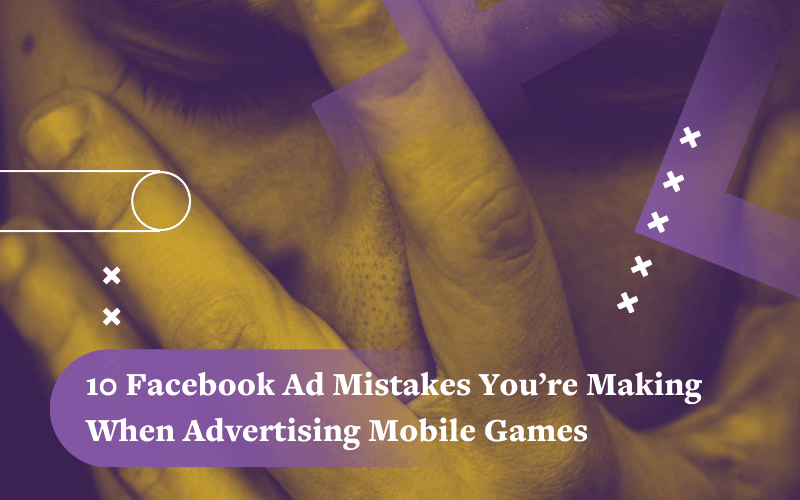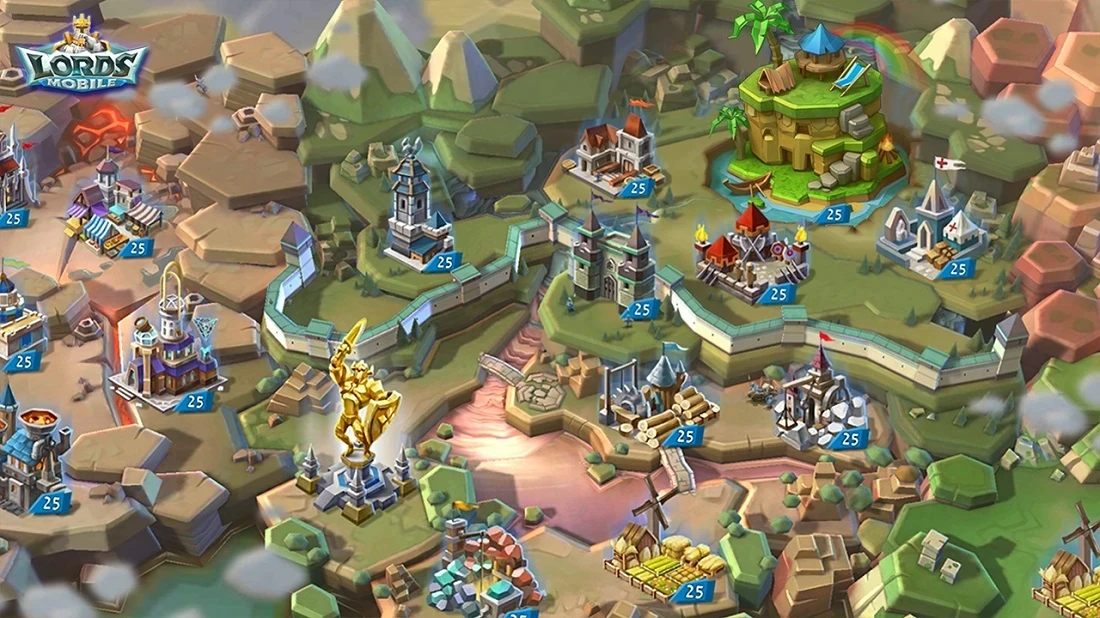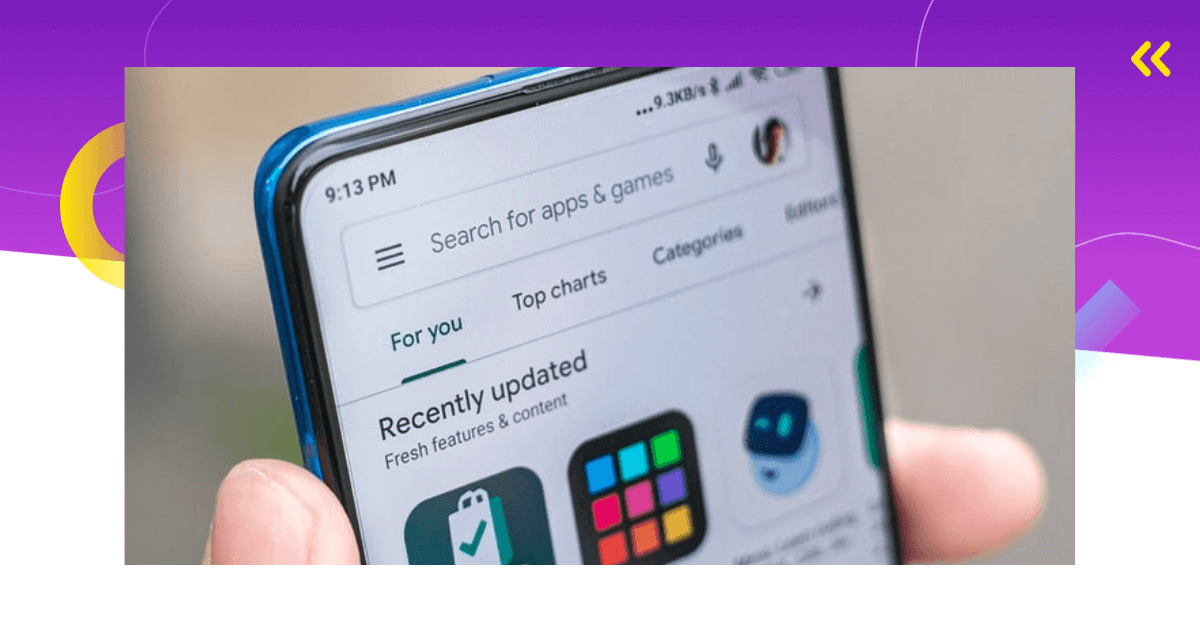If you want to grow the user base of your mobile game, Facebook ads are the way to go. However, we’ve noticed there are many Facebook ad mistakes people are making when marketing mobile games.
That’s why we have decided to put together a list of the most common mistakes and give you tips on what to do instead.
Check it out below!

1. Setting the Ad Budget Too High or Too Low
Let’s start with one of the most common Facebook ad mistakes – setting a budget that’s not optimal for what you’re trying to accomplish. It can either be too high or too low, and both are problematic.
For example, when the ad budget is too low, you’re not going to get enough data, i.e., the sample size will be too small. Therefore, the information you get is not enough to draw any conclusions on the audience, ad placement, or the mobile game itself.
On the other hand, if you set the budget too high, what often happens is that you burn through it without accomplishing any results.
So how do you set the right budget that will allow you to reach goals according to your KPIs?
The answer is, of course, testing.
Set up a campaign and choose a budget of about $25 – this will be your test. Run the campaign for several days, or for as long as it’s necessary to have a big enough sample size. The key here is to get data that will help you come to conclusions and basically give you a starting point.
You can play around with daily budgets in your test campaign and try to identify what works and what doesn’t.
If you choose a small daily budget for your test campaign, you can leave the campaign active for longer in order to achieve an even larger sample size.
2. Not Defining KPIs
So, you start running ads for your mobile game. You know you should optimize them, but you’re not sure how. You’re not even sure how successful your campaigns are.
That’s because you didn’t define KPIs.
This is another one of the common Facebook ad mistakes people make when advertising mobile games.
When you don’t set clear KPIs, you can’t optimize your ads properly. Or know whether something is expensive or not. Without defining KPIs, it’s impossible to measure the performance of your ad campaigns.
That’s not good.
You need to have a clear goal as well as indicators of progress toward that goal. It will help you know what to look for and what to strive for.
As Lewis Carroll said, “If you don’t know where you’re going, any road will get you there.”
An important thing to note is that KPIs are not the same for every industry. They may not even be the same for every mobile game.
However, there are some general KPIs for advertising mobile games that are common like CPI, ROI, retention rate, the number of acquired users, etc.
For example, CPI, or cost per install, is important for mobile game advertising because it tells you how much you pay for one install. You can calculate it by dividing the ad spend by the number of installs (over a specific time period). This KPI helps you determine the viability of your ad campaigns.

3. Targeting the Wrong Audience
You may think, “I know the type of user who’ll want to play my game.”
But do you, really?
Do you know the age or gender of your target audience? Do you know their geographical location? Their interests and behavior?
Unless you have clear data to support it, you’re just guessing. And that’s one of the worst things you can do.
When your ad campaign targets the wrong audience, you’re losing both time and money. Plus, you’re not going to get the results you were hoping for.
Luckily, there’s a surefire way to get insight into who your target audience really is.
The first step is to collect data from your test campaigns and the second one is to analyze it. Provided that the test campaign ran long enough, and the budget was high enough, you can get a lot of valuable user data like age, gender, and location.
That way, there’s no need to guess what’s the age, gender, or location of your target audience. You’ll be able to define it according to the data.
Here’s how that works in a practical way.
Let’s say, you run your test campaign with a $100 budget. After a certain period of time, you shut it down and start looking at the results.
If you go to Breakdowns in Ads Manager, you’ll be able to see what type of users downloaded your mobile game.
For example, it may be that 20% are women between the ages of 18 and 24, 2% are men between 50 and 65+, etc.

4. Choosing the Wrong Bid Strategy
As you might know, Facebook offers four types of bid strategies, i.e., ways to optimize bids. These are Lowest Cost, Bid Cap, Target Cap, and Cost Cap.
Oftentimes, the wrong one is chosen for advertising mobile games. This can have a negative effect on your campaigns, your budget, and your mobile game.
To avoid making these types of Facebook ad mistakes, you need to understand and test each optimization strategy and see which one will bring you the best results.
So, let’s first go through an overview of each one.
Lowest Cost (LC)
This is an auto bid strategy where Facebook’s algorithm finds users who will install a mobile game at the lowest cost (that it can find) while spending the budget in full.
How much it will cost depends on a couple of different things, most importantly: operating system, GEO location, age, gender, etc.
Bid Cap (BC)
Here you set a maximum bid you’re prepared to spend for one install. Thus, CPI can be lower, but it won’t go over that max. bid. Keep in mind that bids management is done manually by the advertiser.
Target Cost (TC)
This bid cap strategy is great for maintaining a consistent cost. You set a CPI, let’s say it’s $2 per install. Then Facebook’s algorithm finds users who will install your mobile game for +/-10% out of that amount ($1.80 – $2.20).
Cost Cap (CC)
Here you keep the cost within a specific threshold – it’s good for cost efficiency. Facebook will find new users for which the average CPI won’t be higher than the set amount.
Here’s the thing about Facebook bid strategies.
A cheaper user doesn’t necessarily equal a better user. Perhaps the more ‘expensive’ user is the one you want. It’s possible for one bid strategy to result in a bigger spend with more high-quality users.
Or that a CPI of $0.50 with the Lowest Cost bid strategy results in lower quality users than a $0.75 CPI you’ll set with a Target Cost.
That’s why you need to play around with bid strategies if your budget allows. It’s a great way to find a good balance of cost and user quality. Moreover, it will allow you to advertise cost-efficiently while scaling your campaigns.

5. Choosing the Wrong Ad Placement
Placements are different places where your ad can run. For example, Facebook feed, Instagram feed, Messenger inbox, etc.
You can choose it manually or let Facebook decide for you.
This is where people often make mistakes. A common mistake is choosing Manual Placement with a new campaign, or not setting it up correctly.
Here’s what you need to do to avoid mistakes.
You shouldn’t rely on your assumptions that something “might work” here. Instead, you should be guided by data.
Sadly, in the beginning, you will have zero data. For this reason, it’s best to let Facebook’s algorithm do its job and find you the best users, and bring you valuable data.
When setting up a new campaign, instead of Manual Placements, choose Automatic Placement.
Once you do this, Facebook’s algorithm will ‘learn’ where the best users are and optimize everything. The algorithm can recognize and decide where to place your ad in order to get the most out of your budget.
After your campaign (ad set) has been on Automatic Placement for about 3 to 5 days or spent about $100, it’s time to analyze the placements.
Now you have data to do so.
Once you’re sure you have identified the best placements for your ads, you can switch to Manual Placement.
Now Facebook will run ads only in places you have chosen.
But keep in mind, this can be a double-edged sword.
If your analysis was good and you have identified the best placements, then all is good. But if you haven’t, CPI may go up, the ad spend may go down, and you simply won’t achieve desired results.

6. Ad Creatives: Common Mistakes
Creatives are crucial for advertising mobile games – it’s what makes users download a game.
There are many Facebook ad mistakes related to ad creatives, so we’re going to go through the most common ones, as well as some tips on how to improve your creatives.
“If I don’t like it, the users won’t like it either”
This is a common trap developers and mobile game advertisers fall into. Remember, just because you don’t find a particular creative interesting, that doesn’t mean the users won’t like it. Not everybody has the same taste as you.
The same goes for the other way around – if you love a creative and are convinced it will make users install your game, this doesn’t mean it will work.
This is why you should never rely on your personal opinions and those of your team, but test each creative and get an objective answer.
This brings us to the next common mistake.
Not Testing Creatives
If you’re not extensively testing your creatives, you’re making a huge mistake. It’s the only way to know for sure whether something works and why.
A/B tests are the most effective for getting data on ad creatives. They allow you to test ad creatives against one another, as well as to test every single aspect of an ad creative including visuals, effects, music, ad copy, CTA, etc.
Using the Same Creatives Over and Over Again
When advertising mobile games, you’ve got to keep it fresh. If your target audience sees your ads too frequently, this will inevitably lead to ad fatigue.
When this happens, your audience will get bored of your ads. As a result, your campaigns will become more expensive and ineffective.
There are three metrics that clearly indicate your audience is tired of your ads. Keep an eye on:
- high ad frequency
- lowered CTR
- increased CPC/CPI
Don’t let users get bored. A good rule of thumb is to add one or two brand-new creatives to your campaign each week.
It doesn’t matter whether existing creatives work or not. Adding new creatives consistently allows you to test them as well as avoid being repetitive.
Not Producing Different Ad Dimensions
If you produce only one or two ad dimensions for your creatives, you’re limiting your campaign’s reach.
The thing is, Facebook Feed, Marketplace, Right Column, Instagram Story, Instagram Feed and other placement on Facebook all come with their own requirements.
If you have a full set of ads in different dimensions, this should help you reach all the areas where your potential users may be.
Not Localizing Creatives
Another mistake is ignoring the power of localization. Translating your creatives to another language will broaden your reach and improve the effectiveness of the campaign.
However, simply changing the voiceover to a different language or adding captions is sometimes not enough.
For example, let’s say your main target markets include the US, Germany, France, Japan, and India. Mobile gamers from these countries have different tastes and behaviors. That sometimes calls for completely different creatives and messages.
For example, you might find that, for German audiences, ad creatives that emphasize how relaxing it is to play your game work best. That same creative might not get good results at all in Japan. Instead, ad creatives that are more dynamic rather than relaxing might work better.
Whatever it may be, find out what works in different regions and adjust your creative strategy accordingly.
Not Utilizing The Power of Video Ads
There is no other ad format that shows off a mobile game as well as video ads. Their role is to grab attention, make the game look interesting, and finally, boost downloads. Here are a few tips to help you create great video ads for social media:
- keep it short and simple (15-30 seconds)
- grab attention early
- have a consistent visual style
- highlight the game’s best features
- optimize for mute viewing
- end with a CTA
- watch out for social media requirements

7. Having a Poor Campaign Structure
This is often overlooked, but a good structure is very important when creating ad campaigns for mobile games.
Put simply, it’s not good to have too many ad sets in a campaign or too many ads in an ad set.
We at Udonis have created thousands of Facebook campaigns for mobile games. From our experience, we recommend that you use three to five ad sets per campaign. This proved to be the optimal number in our experience.
Furthermore, the optimal number of ads per ad set is ten.
That way, there’s enough ‘room’ to run all the ad sets and ads so that all of them can be tested. This allows you to identify the most effective ads, i.e., the winners. Those are the ads that come out of the testing phase with the lowest CPIs.
8. Writing a Bad Primary Text and Headline That Doesn’t Convert
When writing a Primary Text and Headline, people often wonder, should it be longer or shorter? What kind of message should I send to a potential user? Should it be localized or not? Should I use emojis or not?
There’s a lot you can do wrong here and it results in an ad that simply doesn’t convert.
Here are a couple of tips on how to avoid these types of Facebook ad mistakes.
For one ad, you should write two or three Primary Texts and Headlines. Just like with creatives, you can’t know which one will work and which won’t, so this is a good way to test it.
When it comes to optimal length, three to five short sentences are enough for a Primary Text. You should write what your mobile game is about, what are its benefits, and why should users download it.
We recommend that you always use emojis on Facebook. Love them or hate them, emojis have become the standard way of communicating in the 21st century and people love it.
Furthermore, don’t place a key sentence at the end, make it the first one. On Facebook, the last part of the Primary Text will be hidden and users can see it only by clicking “see more”.
When it comes to Headlines, keep it short. Three to five words is more than enough – you simply need to write the mobile game name and some type of a catchword or a slogan. Everything else is said in the Primary Text.
Finally, we recommend that you translate the Primary Text and Headline into the languages of countries you’re targeting.
9. Not Taking Full Advantage of CTAs
A call to action, known as CTA, is often overlooked and considered unimportant.
That couldn’t be further from the truth.
Not adding a CTA is one of the biggest Facebook ad mistakes you can make. A CTA can significantly boost the effectiveness of your campaign.
Just make sure it corresponds to the action you want the user to take. For example, when advertising a mobile game, don’t add “Learn more”. You want the users to play the game, so go with “Play Game”. You can also choose “Download” or “Install Now”.
10. Choosing ASBO Instead of CBO
Let me first explain what ASBO and CBO are.
ASBO stands for Ad Set Budget Optimization which is when you set the budget at an ad set level. Each ad set can have a different budget.
CBO stands for Campaign Budget Optimization. That means you set a budget on a campaign level, then Facebook allocates and spends it.
Here’s why choosing ASBO instead of CBO is another one of common Facebook ad mistakes.
When you choose ASBO, it can happen that there’s an ad set that works really well but because of ASBO, it can’t spend more that day. Or it can happen that you’re wasting your budget on an ad set that’s not producing good results.
But if you choose CBO, Facebook decides for you – it lets the algorithm allocate the budget. So if a particular ad set is performing well, the algorithm will put more money towards that ad set.
This also allows you to see where the money was spent and optimize your campaign according to that.
11. Not Utilizing Facebook Automated App Ads
Facebook’s Automated App Ads are one of the best ways to advertise mobile games – if you’re not using them, you’re making a mistake. What makes AAA unique is that they require less output, hence the name. You don’t need to rely on manual adjustments.
Furthermore, you can have one ad set and one ad per campaign with AAA. With standard campaigns, you can have multiple ad sets and ads per campaign.
Another great feature of Facebook’s Automated App Ads is Dynamic Creative Optimization. This tool for creative testing got special traction when Apple introduced IDFA changes. The thing is, with IDFA depreciation, campaign configurations became limited. Therefore, game advertisers are no longer able to test hundreds of variations for the same ads.
It helps you automatically test different creatives and identify best-performing ads. The only thing you need to do is upload up to 50 images/videos, and up to 5 headlines and descriptions.
That makes it easier to optimize for certain goals, scale campaigns, test creatives, reach more users, and achieve goals faster.
Learn more here.
Final Thoughts on Facebook Ad Mistakes
Facebook ad campaigns are hands down one of the best ways of advertising mobile games. However, creating campaigns that produce good results, and get you high-quality users, is not easy.
If you need any help avoiding these Facebook ad mistakes, make sure to reach out. We specialize in mobile game marketing and have years of experience in creating Facebook ads.







Comments